There’s a particular facility where I find myself spending a significant amount of time working. It’s a nice place, fairly new, and the people who work there are very friendly and helpful. The one thing that always strikes me as odd about it, though, is their overzealous commitment to not only “being green,” but in the lengths they go to in order to prove just how “green” they are. In fact, they’ve made some changes in recent months that I feel take the concept to a ridiculous level. Even though I’m not supposed to be allowed to bring a camera into this facility (which is part of the reason why I’m not mentioning the name of it), I went ahead and took some pictures with my phone to show what I’m talking about.
When we first moved into this place, I spent about a month working there every day. I then had no need to be physically present for a couple of months, but recently I’ve found myself there again most days. The first time I returned after an absence, the fact that they’d made some changes (I’m sure they’d call them “improvements”) was obvious even from the parking lot:
The spots with the white signs—the ones that are actually closer to the entrance than the handicapped spots—are now reserved for “low-emitting/fuel efficient vehicles.” (Yes, I realize that the handicap parking spots are closer to the wheelchair ramp in the sidewalk, but it still seems funny to me that if you drive a Prius you get a shorter distance to travel to the entrance than somebody in a wheelchair.)
Of course, the several times that I’ve been to this place since noticing the appearance of these signs, I’ve never seen a vehicle parked in those spaces, low-emitting or otherwise. I’ve considered using them myself, just because, but I’m pretty sure they have carte blanche to tow me if they so choose.
On the front door to the facility is a sticker proudly proclaiming that they are a “Bay Area Green Business,” which I suppose isn’t such a big deal, as far as self-congratulating back-patting goes.
What cracks me up the most about this place, though, are the bathrooms. They, too, have been renovated in order to become more “green,” and the results are nothing if not strange. The urinals in the men’s rooms were replaced by “waterfree” versions:
A quick search reveals that these are the WES-2000 model from Sloan, which utilizes some sort of cartridge to collect “sediments” while all liquid goes down the drain. Visible on the wall in the above picture (next to the capped pipe end where the water supply for the old urinal used to be) is a sign that they’ve proudly mounted, informing the user of the great environmental impact of using waterfree urinals.
I’ve had plenty of opportunities, while standing in front of these things, to do the quick mental math required to become a bit dubious of this claim. If the average “normal” (“old?”) urinal uses 40,000 gallons of fresh water per year, at 1.6 gallons per flush, that means it is flushed 25,000 times per year, or 68 times a day. Maybe in a busy bar, I could see this, but in a low-traffic establishment (which this is), that seems preposterous to me. (Even Sloan’s own website doesn’t make such lofty claims, estimating the water savings instead between 9,600 and 24,500 gallons per year… Although, if Sloan didn’t make that sign, who did?)
I assume that I’m not alone in that, when hearing the words “waterfree urinal,” the first thing I think of is “stale-piss-smelling bathroom.” Thankfully, this is not the case. The WES-2000 has some sort of air freshener in it, so that it always exudes a strong scent of cinnamon, which is decidedly better than the alternative.
The eco-friendly measures in the bathroom don’t stop at the urinals, though. They’ve also replaced the flushers on the toilets in the stalls with the “UPPERCUT,” a water-saving “flushometer”:
The bright-green flusher handle is the “Dual-Flush Flushometer.” My favorite part of all of this, I think, is the sign describing how to make use of its water-conserving features:
This is without a doubt the most formal use of the terms “#1” and “#2” I’ve ever seen. I didn’t receive a copy of the memo, but thankfully this sign is there to help explain things for me. (I also note how much exaggeration is inherent in the little water-droplet icons: they seem to imply that the “up” flush uses 1/3 the amount of water as the “down” flush, but in fact the ratio is actually a little over 2/3—1.1 gallons instead of the typical 1.6.)
Personally, I think they should have a special sticker one receives as reward for taking a dump that can be flushed with the “up” flush. It certainly wouldn’t surprise me to see “I’m a green pooper!” bumper stickers while driving around Silicon Valley. That’s how these people are.

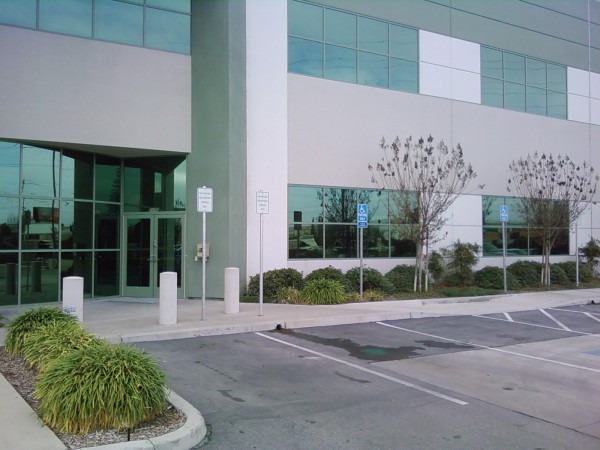
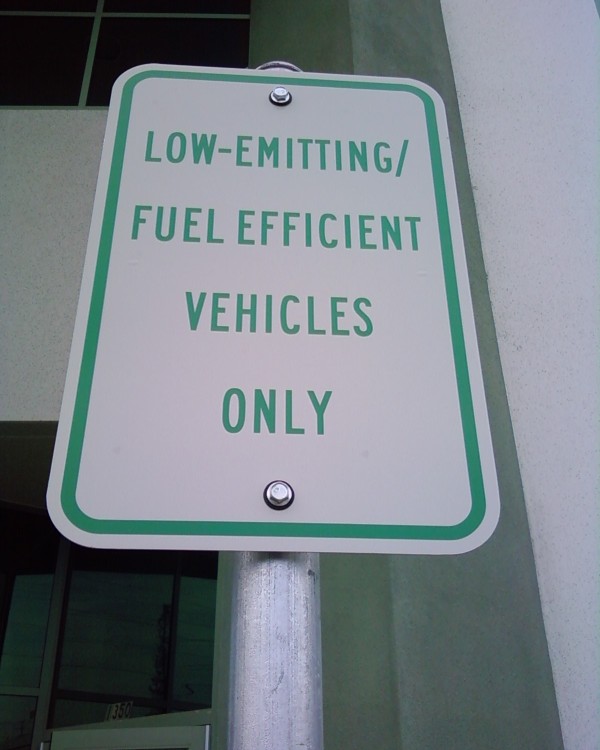
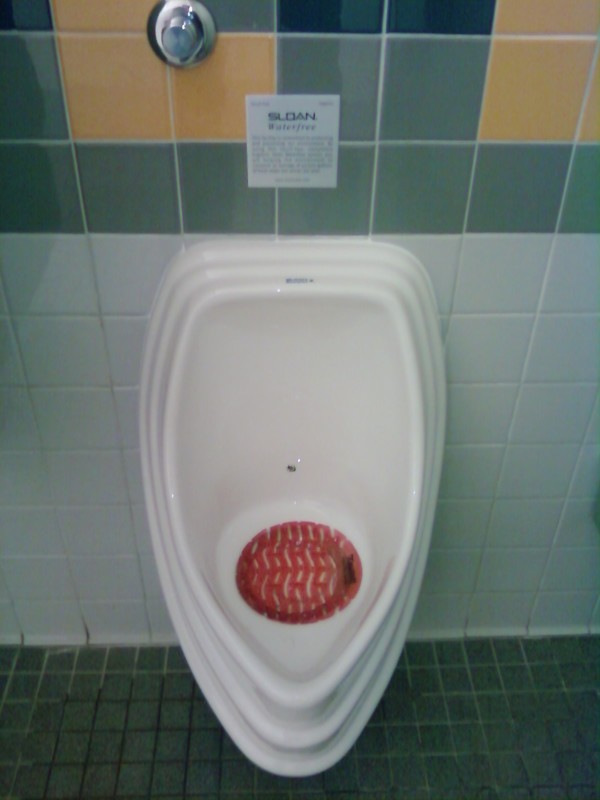
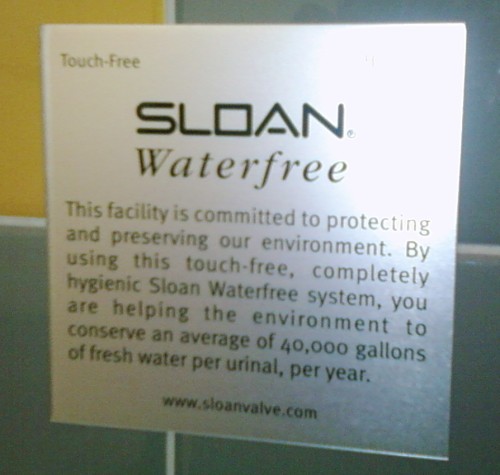
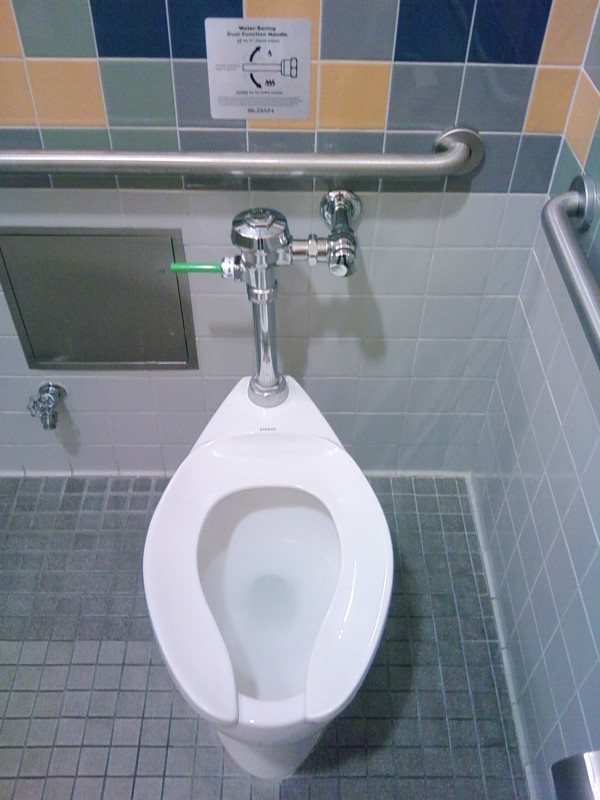
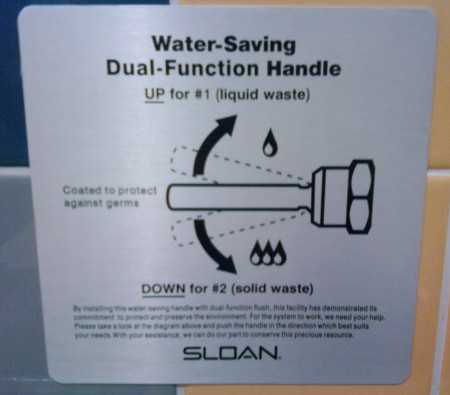


So that’s what those signs say. I saw one of those water-free pissoires at a rest area, but I wasn’t wearing my glasses so I couldn’t read the sign.
I wouldn’t think most standard urinals use 1.6 gallons per flush, so their claim of solving the world’s water problems are even more outrageous. Sooner or later, the pipes will start to clog with sediment and then all the cinnamon in the world won’t hide that stench.
The fact that no one parks in those spots means that no one there is green enough to drive a Prius. I wonder where the owner parks his Mercedes.
Good point—their site actually is calculating the savings based on the water usage of toilets (1.6 gallons for low-flow models, up to 3.5 gallons per flush for old-school ones), not conventional urinals.
Oddly enough, I’ve seen Priuses in the parking lot there. Just not in the designated spots.
Perhaps the Prius-driving employees actually enjoy to walk a couple of meters?
We have those urinals here at Goodfellow Air Force Base. However, they neglected to include the spiffy little signs explaining their water-free nature, so the first time I used one I spent a good two minutes trying to figure out how to flush it.
All I need is a hole in the ground to poop and piss in. Doin’ it the traditional old school outhouse way! ;) That’s how my dad did it growing up, and I’m sure we’ll end up that way. Indoor plumbing is SO 20th century wastefulness.
This is consistent with my perception of San Francisco attitudes in general. Which is to say: not necessarily bad or wrong, just obnoxiously preachy and self-righteous.
They had the two-flush option toilets everywhere when I was in Iceland, and it took me a minute to figure out what it was. Unlike those, they were not labeled, and they tended to be in the form of a panel with two buttons, one larger than the other, completely unmarked.